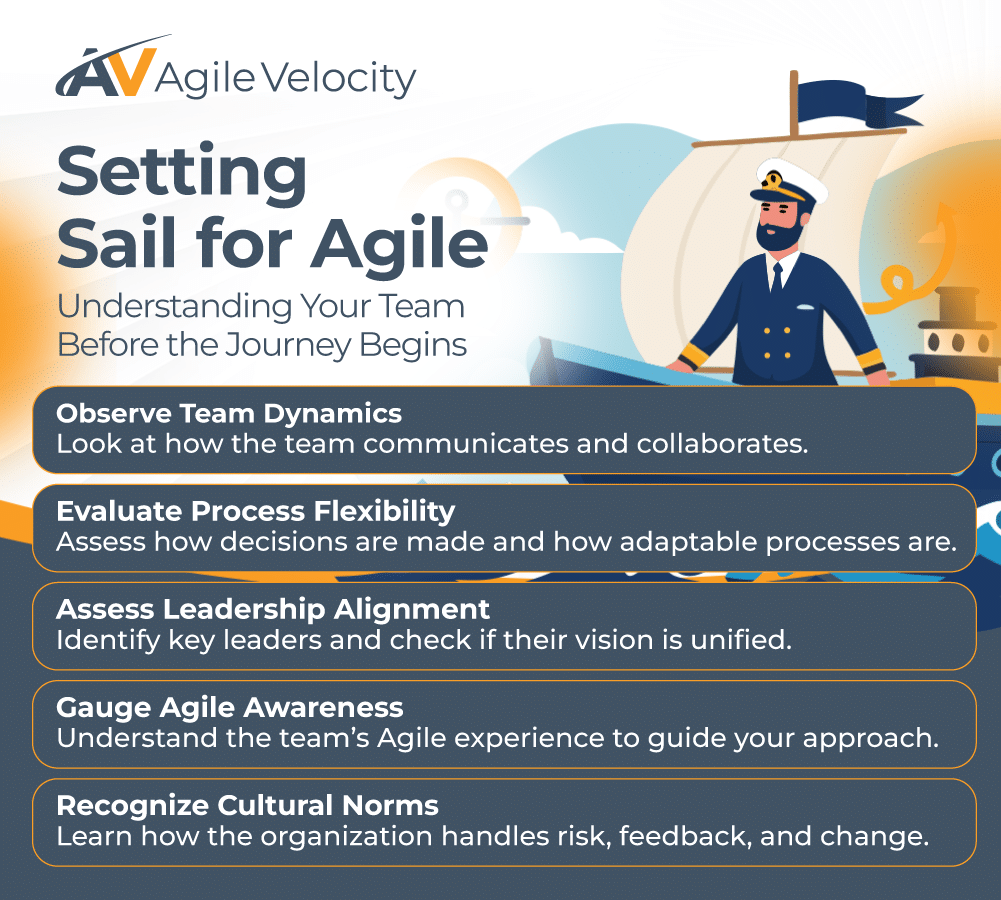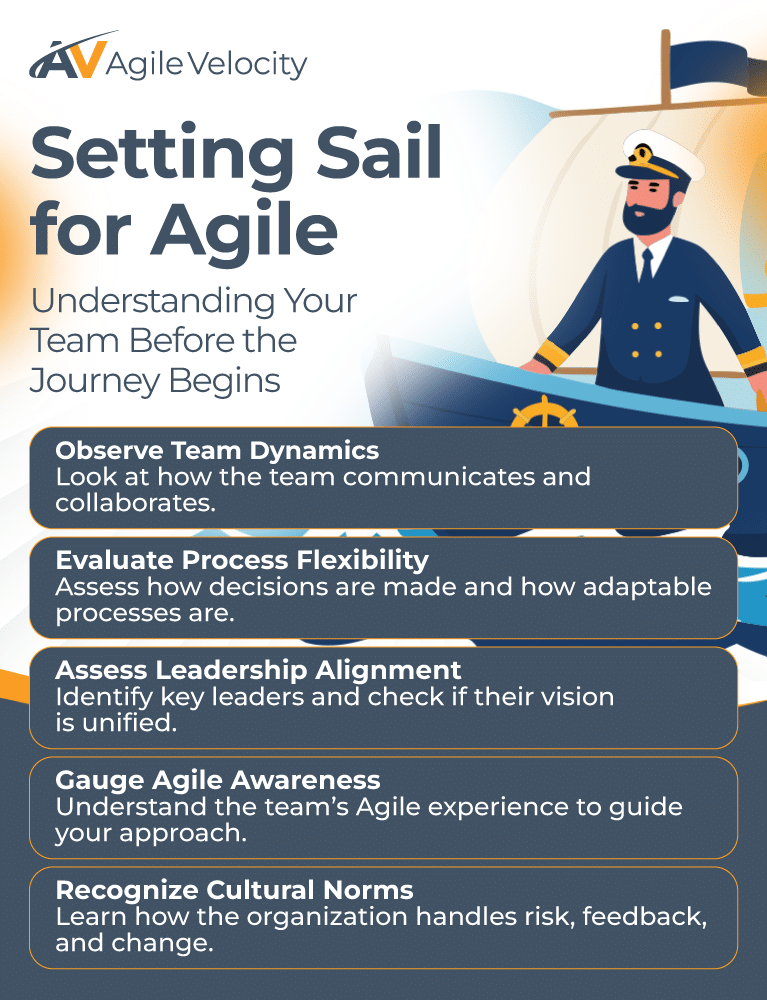Stepping into a leadership role at a new company is both an exciting and challenging endeavor—especially when your goal is to implement an Agile Transformation. You’ve experienced firsthand how Agile Methodologies drive value, foster innovation, and improve collaboration. Your previous successes can help channel change in an environment where existing processes aren’t optimized for Agile. How do you spark lasting change while navigating a new organizational landscape?
This guide provides actionable strategies to introduce and embed Agile adoption strategies in your organization. We will cover how to assess your new terrain, build a solid foundation, secure leadership support, pilot Agile practices that deliver measurable business outcomes, and integrate Agile across various facets of your enterprise. Let’s dive in.
Navigating Uncharted Waters Before Steering the Agile Ship
When you step into a new leadership role, it is crucial to understand the unique ecosystem you’ve entered. A thoughtful evaluation of your team’s dynamics, leadership alignment, and organizational culture sets the stage for a successful Agile journey.
Observing Team Dynamics
Begin by observing how teams function. Notice if processes are rigid or if there is flexibility for collaboration. Understand whether decision-making is hierarchical or shared among team members.
Assessing Leadership Alignment
Identify key decision-makers and gauge whether they share a unified vision. Leadership alignment is essential to setting a tone that supports change.
Gauging Agile Awareness
Determine the team’s familiarity with Agile practices. Some groups may have experimented with Agile in isolation, while others might need a full introduction. Understanding this helps you tailor your approach.
Recognizing Cultural Norms
Evaluate how the organization handles risk, feedback, and setbacks. Agile thrives in a culture that embraces experimentation and learning rather than rigid adherence to existing processes. By taking time to understand your organization’s landscape, you lay the groundwork for a transformation that is both empathetic and purpose-driven.
Building the Foundation for Agile Transformation
Before launching full-scale changes, it is essential to build a foundation that gains trust and demonstrates clear value.
Establishing a Clear Purpose
Define the “why” behind the transformation. Focus on measurable business outcomes—such as reducing time-to-market, enhancing product quality, or increasing team collaboration—and tie Agile practices to these objectives so every team member understands what is at stake.
Engaging Stakeholders
Identify key supporters among senior executives, department leads, and frontline team members. Engage these groups early with clear, concise messages that relate Agile benefits to their responsibilities. Involving stakeholders creates a sense of shared ownership.
Developing an Actionable Roadmap
Craft a simple, phased roadmap that outlines:
- A pilot project with manageable complexity.
- Success metrics tied to business outcomes.
- Plans for training and support.
A well-defined roadmap creates clarity, minimizes resistance, and builds momentum from early wins. This also helps align your transformation goals with broader organizational objectives, ensuring that each step is strategically positioned for long-term success.
Securing Leadership Buy-In
Leadership support is vital to transforming processes at scale. To secure buy-in:
Aligning Agile With Business Goals
Demonstrate how Agile practices support outcomes that matter—faster product releases, cost savings, and improved customer satisfaction. Use concrete examples and data from past successes to illustrate these benefits.
Showcasing Real-World Impact
Launch a small pilot and track key metrics like lead time, defect reduction, and delivery predictability. Share these results with leaders to highlight how Agile drives tangible improvements.
Involving Leaders in Agile Events
Invite executives to participate in Agile events such as Sprint Reviews and Sprint Planning sessions. Direct exposure to these practices helps demystify the process and builds confidence in its value.
For leaders looking to align investments and objectives effectively, a Lean Portfolio Management approach ensures that your organizational priorities remain front and center throughout the transformation.
By translating Agile benefits into terms that resonate with the rest of the leadership team, you overcome hesitancy and lay the groundwork for broader adoption.
Practical Steps for Introducing and Integrating Agile
Integrating Agile doesn’t require a company-wide overhaul overnight. Start with focused, manageable steps:
Begin With a Pilot Project
Select a low-risk project to introduce core Agile events:
- Sprint Planning: Set clear, achievable goals.
- Daily Scrum: Monitor progress with short sync sessions.
- Sprint Review and Retrospective: Evaluate what worked and identify improvements.
These sessions help teams adjust gradually while building confidence through early wins.
Provide Targeted Agile Training
Offer concise training sessions that cover:
- Core Agile principles and frameworks such as Scrum or Kanban.
- Key roles like Scrum Master and Product Owner.
- Best practices for iterative delivery and continuous improvement.
Tailoring instruction to specific roles makes it easier for teams to embrace new methods. Consider enrolling in Agile Training workshops to equip teams with the knowledge needed for success.
Foster Collaboration and Transparency
Encourage cross-functional teamwork and the use of visual tools—such as Kanban Boards—to track progress. Open communication channels ensure that everyone stays aligned with the transformation’s objectives.
Starting small and focusing on measurable improvements will help demonstrate Agile’s value—and create a model that can be scaled across the organization.
Scaling Agile Across the Organization
Once the pilot proves successful, expand Agile practices with care to maintain consistency and quality.
Choosing a Scaling Framework
For broader adoption, frameworks like SAFe® or Scrum@Scale™ offer structured approaches to manage complexity across multiple teams. Select the framework that best fits your organization’s size and culture.
Aligning Teams and Strategy
Ensure that every team’s efforts are linked to strategic goals. Practices such as Lean Portfolio Management help prioritize initiatives and maintain organizational focus on high-impact results.
Maintaining Core Agile Values
Even as you scale, continue to emphasize essential Agile practices:
- Regular retrospectives to refine processes.
- Empowering teams to make decisions locally.
- Upholding transparency, collaboration, and continuous learning.
For organizations planning to expand beyond a single team, exploring SAFe transformations can help structure large-scale rollouts while maintaining a cohesive Agile mindset.
Scaling Agile effectively means extending successful practices without losing the core values that drive success.
Integrating Agile Across Functional Departments
A comprehensive transformation isn’t limited to the IT or development teams. It is beneficial to extend Agile practices to other parts of your organization—such as marketing, sales, finance, and operations.
Cross-Departmental Collaboration
Encourage departments to adopt Agile principles tailored to their functions. For instance, marketing teams can benefit from iterative campaign planning and rapid feedback loops, while sales teams may use Agile techniques to adjust strategies quickly based on customer interactions and market trends. This inclusivity breaks down silos and builds a culture of continuous improvement organization-wide.
Customizing Agile Practices
Different departments may not require the same intensity of Agile events as software teams, but they can still incorporate key elements like regular check-ins, transparent metrics, and adaptive planning. Customizing practices ensures that Agile Methodologies are adapted to meet diverse departmental needs.
Measuring Cross-Functional Impact
Develop department-specific KPIs that align with your overall business objectives. For example, finance might track cycle times for budget approvals, while operations might focus on process optimization metrics. Sharing these metrics fosters a unified approach and highlights the broader impact of an Agile Transformation.
Overcoming Resistance to Change

Resistance is a natural part of any transformation. To address and overcome pushback:
Build Understanding With Reassurance
Clarify that Agile is not about constant oversight but about enhancing collaboration and empowering teams. Address common fears directly by explaining how Agile improves visibility and decision-making.
Highlight Personalized Benefits
Emphasize how Agile benefits team members at every level:
- For Developers: Faster feedback and clearer requirements.
- For Managers: Predictable delivery and improved resource management.
- For Executives: Enhanced responsiveness to market changes.
Foster a Safe Environment for Feedback
Encourage team members to share their concerns in a non-punitive setting, such as during retrospectives. A culture that values honest feedback makes it easier to address issues before they escalate.
Invest in Agile Coaching
Leverage the expertise of Agile Coaches who can provide tailored guidance and help debunk misconceptions. Their support is invaluable in smoothing the transition and reinforcing best practices.
If you’re aiming to identify hidden bottlenecks or patterns in team behavior, AI can provide data-driven insights for more targeted improvements.
By addressing concerns with clear communication and focused support, you help convert resistance into engagement.
Maintaining Momentum Through Continuous Improvement
Integrating an Agile Transformation is an ongoing journey that relies on continuous learning and adaptation.
Prioritize Regular Retrospectives
Hold frequent retrospectives to evaluate what is working and identify areas for improvement. These sessions reinforce a cycle of continuous improvement and ensure that adjustments are made in a timely manner.
Leverage Meaningful Metrics
Track key performance indicators (KPIs) such as:
- Delivery Predictability: The consistency of meeting targets.
- Quality Metrics: Improvements in product performance and defect rates.
- Engagement Levels: Team morale and collaboration rates.
Using data to drive decisions helps sustain momentum and justify further investment in Agile practices.
Foster a Culture of Learning
Encourage ongoing training, internal workshops, and knowledge-sharing sessions. A learning culture keeps teams up-to-date with evolving practices and ready to adapt to new challenges.
Embracing Technology for Agile Monitoring
Integrate software solutions that provide real-time dashboards and automated reporting. These tools help in visually tracking progress against planned milestones and can alert leaders to potential bottlenecks for timely course corrections.
As hybrid and remote teams adapt to evolving collaboration models, Return to Office Events can also be shaped by Agile principles to keep employees engaged and productive.
Sustaining Agile Culture Beyond the Initial Transformation
An Agile Transformation does not end with the initiation of new practices; sustaining the momentum over the long term is equally vital. Beyond the early wins, it is important to embed Agile into the fabric of your organization.
Strengthening Cross-Team Collaboration
Create a structured approach for sharing insights across various groups. Regular inter-team forums or casual cross-departmental check-ins can serve as platforms for discussing challenges and celebrating successes. This exchange fosters organic scaling of best practices and unifies efforts toward organizational goals.
Monitoring and Adapting Processes
As your organization settles into its new Agile rhythm, consider establishing a lightweight governance framework to periodically review processes. This framework focuses on ensuring that teams remain aligned with broader objectives, with ongoing adjustments based on feedback keeping your implementation dynamic and responsive.
Celebrating Milestones and Acknowledging Contributions
Recognize that transformation is a gradual process. Celebrating small wins and acknowledging team contributions reinforces a positive outlook and motivates continued engagement. A culture that celebrates progress boosts morale and encourages proactive problem-solving.
Investing in Professional Growth
Sustainability in Agile requires ongoing investment in professional development. Regular training sessions, peer-learning opportunities, and mentoring programs can help solidify Agile practices. Empower individuals to share ideas that refine processes and improve outcomes.
When you need to fill gaps for specialized roles or if you’re in need of additional expertise to support these initiatives, consider leveraging Agile Staffing solutions for on-demand guidance in finding the right talent.
Looking ahead, it is important to remain adaptable and prepared for unexpected changes. Integrating continuous market insights and technological advancements into your Agile strategy helps your organization stay competitive and responsive. Embracing future challenges with a flexible mindset will further strengthen your transformation journey.
Leveraging Path to Agility® Navigator for Sustainable Change
For many organizations, the complexity of Agile Transformation can be overwhelming. This is where Path to Agility® Navigator offers a tangible solution.
Enabling Focused Change
Path to Agility Navigator helps identify specific areas of improvement, ensuring that the transformation is focused and measurable. It guides teams through actionable steps and tracks progress in real time.
Providing a Structured Roadmap
The tool offers tailored recommendations based on current performance, making it easier to prioritize changes and sustain momentum. It transforms the often abstract concept of Agile Transformation into a clear, trackable process.
Combining Expertise and Technology
When integrated with expert guidance, Path to Agility Navigator ensures that your Agile journey is not only structured but also aligned with strategic business objectives. This combined approach makes it easier to achieve lasting organizational agility.
Utilizing Path to Agility Navigator transforms your transformation from a broad goal into a series of targeted, achievable steps.
Integrate Agile and Transform Team Dynamics for Success
Stepping into a new leadership role is a prime opportunity to reimagine how your organization collaborates and delivers value. With clear goals, a strategic pilot, stakeholder buy-in, cross-departmental integration, and the support of tools like Path to Agility Navigator, you can drive an Agile Transformation journey that reshapes your company’s culture and performance.
Agile Velocity is here to support you every step of the way. Whether you need expert Agile coaching, Lean Portfolio Management, or structured tools to track progress, our approach is focused on achieving real business results—not just technical implementations. To discover how we have successfully helped other organizations succeed, check out our customer success stories.
Lead your organization with empathy, adaptability, and a commitment to continuous improvement. While Agile is increasingly influential—driving flexibility, collaboration, and innovation—they form part of a broader spectrum of approaches shaping the future of work. Embrace your Agile journey as one powerful path among many, and let it guide you toward innovative and effective ways of working.





